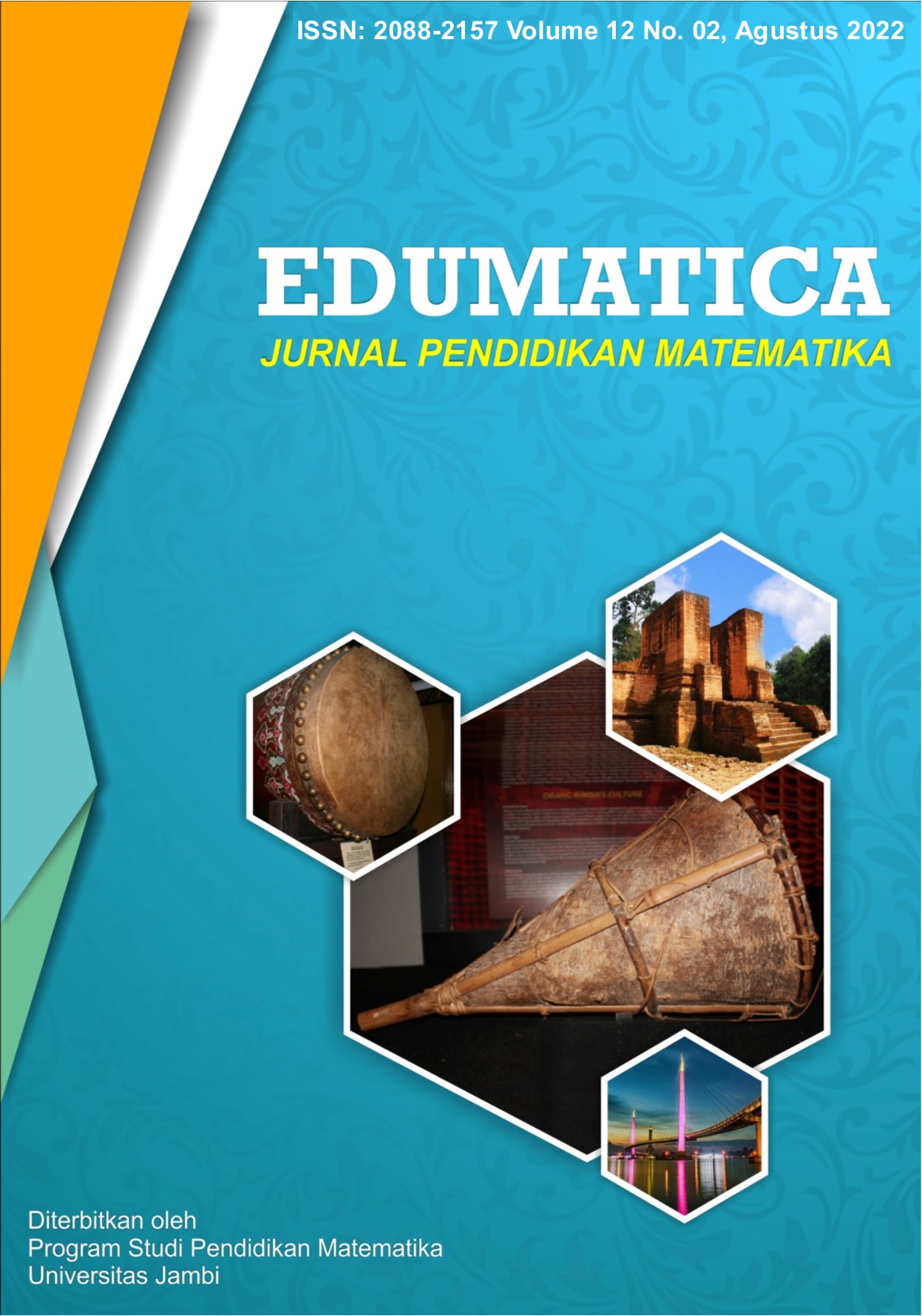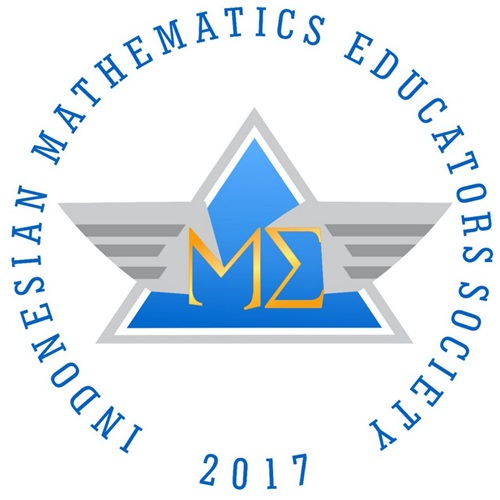Student's Intrinsic Cognitive Load of Guardian Personality in Solving Mathematical Problems in Terms of Learning Style
DOI:
https://doi.org/10.22437/edumatica.v12i02.12856Keywords:
guardian personality, intrinsic cognitive load, learning style, problem solvingAbstract
The intrinsic cognitive load of each student is different in solving math problems. This study aims to describe the intrinsic cognitive load of students with guardian personality in solving math problems at SMK PGRI 1 Tulungagung with learning styles. This research uses qualitative research with a case study approach. Collecting data using tests, questionnaires to classify personality types and learning styles, and interviews. Tests and questionnaires were carried out in class XI, then 6 research subjects were selected to represent the guardian personality with visual, kinesthetic, and auditory learning styles. Data analysis techniques are carried out through the data reduction stage, data presentation, and drawing conclusions. The results showed that the thinking process of guardian personality students with learning styles was: (1) visual. Students do not know what concepts are used to solve the questions, students do not know the formulas used to solve the questions, and students cannot solve the questions until the end correctly because they do not know how to do them; (2) kinesthetic. Students do not know what concepts are used to solve the questions and students know the formulas used to solve the questions, and students cannot solve the questions until the end correctly because students do not understand correctly what is being asked in the problem; (3) auditory. Students understand what is known and asked about the problem so that they are able to solve the problem correctly.
Downloads
References
Apipah, Salisatul dan Kartono. (2017). Analisis Kemampuan Koneksi Matematis Berdasarkan Gaya Belajar Siswa pada Model Pembelajaran VAK dengan Self Assassment. Unnes Journal of Mathematics Education Research, Vol. 6, No. 2, hal. 148-156.
Ariefia, Helida Evanty, Abdur Rahman As’ari, and Hery Susanto. (2016). Proses Berpikir Siswa Dalam Menyelesaikan Permasalahan Pada Materi Trigonometri. Jurnal Pembelajaran Matematika Tahun III, No.1, hal. 28-32.
Bencsath, K. & Halmos, P.R. (1997). Problem Books in Mathematics. Germany: Springer.
Hendriana, Heris & Fadhilah, Fika Muji. (2019). The Student's Mathematical Creative Thingking Ability Of Junior High School Through Problem-Solving Approach. Journal of Mathematics Education, Vol. 8, No.1, hal. 11-20. https://doi.org/10.22460/infinity.v8i1.
Jong, Ton de. (2010). Cognitive load theory, educational research, and instructional design: Some food for thought. Instructional Sciences. 38: 105-134. DOI: 10.1007/S11251-009-9110-0
Keirsey, David. (1998). Please Understand Me II Temperament Character Intelligence First Edition. USA: Prometheus Nemesis Book Company.
Khamidah, Khusnul dan Suherman. (2016). Proses Berpikir Matematis Siswa dalam Menyelesaikan Masalah Matematika Ditinjau dari Tipe Kepribadian Keirsey. Al-Jabar: Jurnal Pendidikan Matematika, Vol. 7, No. 2, hal. 231-248.
Lin, H. dan Lin, J. (2013). Cognitive load for configuration comprehension in computer-supported geometry problem solving: An eye movement perspective. International Journal of Science and Mathematics Education. 12, 605-627.
Nurkaeti, Nunuy. (2018). Polya’s Strategy: An Analysis Of Mathematical Problem Solving Difficulty In 5th Grade Elementary School. EduHumaniora: Jurnal Pendidikan Dasar, Vol. 10 No. 2, hal. 140-147.
Paas, Fred, Gog, Tamara van, & Sweller, John. (2010). Cognitive load theory: New conceptualizations dampak pandemi covid-19 terhadap proses pembelajaran online di sekolah dasar, spesifications, and integrated research perspectives. Educ Psychol Rev, 22, 115-121. DOI: 10.1007/s10648-010-9133-8
Plass, L. J., Moreno, R. & Brunken, R. 2010. Cognitive Load Theory. New York: Cambridge University Press.
Polya, G. (1973). How To Solve It (Second Edition). New Jersey: Princeton University Press.
Purnomo, Ragil J., Widodo, Sri A., dan Setiana, Dafid S. (2020). Profil Berpikir Siswa dalam Memecahkan Masalah Matematis Berdasarkan Model Polya. Range: Jurnal Pendidikan Matematika, Vol. 1, No. 2, hal. 101-110.
Retnowati, E. (2012). Worked examples in mathematics. 2nd International STEM in Education Conference (pp. 393-395). Beijing: Beijing Normal University.
Sari, Ariesta Kartika. (2014). Analisis Karakteristik Gaya Belajar VAK (Visual, Auditorial, Kinestetik) Mahasiswa Pendidikan Informatika Angkatan 2014. Jurnal Ilmiah Edutic, Vol. 1, No.1.
Sugiyono. (2016). Memahami Penelitian Kualitatif. Bandung: ALFABETA.
Sunarto, M.J. Dewiyani, Budayasa, I Ketut, & Juniati, Dwi. (2017). Profil Proses Berpikir Mahasiswa Tipe Kepribadian Sensing Dalam Memecahkan Masalah Logika Matematika. Cakrawala Pendidikan, No. 2, hal. 299-308.
Sweller, John. (1994). Cognitive load theory, learning difficulty, and instructional design. Learning and Instruction, 4(4), 295-312. (Online).
Sweller, John. (2010). Element Interactivity and intrinsic, extraneous, and germane cognitive load. Educational Psychology Review, 22, 123-138. https://doi.org/10.1007/s100648-010-9128-5.
Sweller, John, Ayres, Paul & Kalyuga, Slava. (2011). Cognitive Load Theory. New York: Springer, (Online).
Tindall-Ford, Sharon, Agostinho, Shirley & Sweller, John. (2020). Advances In Cognitive Load Theory: Rethinking Teaching. New York: Routledge Taylor & Francis Group.
Tomia, Fitri, Sopamena, Patma, & Abdillah. (2018). Beban kognitif siswa dalam menyelesaikan masalah pertidaksamaan linear satu variabel kelas vii mts negeri ambon. Prosiding SEMNAS Matematika & Pendidikan Matematika IAIN Ambon, 83-93. https://www.researchgate.net/publication/325381649
Yanti, Avissa Purnama, & Syazali, M. (2016). Analisis Proses Berpikir Siswa Dalam Memecahkan Masalah Matematika Berdasarkan Langkah-Langkah Bransford dan Stein Ditinjau dari Adversity Quotient Siswa Kelas X MAN 1 Bandar Lampung Tahun 2015/2016. Jurnal Pendidikan Matematika: Al-Jabar, Vol. 7, No.1, hal. 108-122.
Yohanes, Barep, Subanji, & Sisworo. (2016). Beban kognitif siswa dalam pembelajaran materi geometri. Jurnal Pendidikan: Teori, Penelitian dan Pengembangan. 1(6), 187-195.
Yohanes, Barep,& Lusbiantoro, Rendi. (2019). Teori Beban Kognitif: Elemen Interaktivitas Dalam Pembelajaran Matematika. INSPIRAMATIKA: Jurnal Inovasi Pendidikan dan Pembelajaran Matematika, 5(1).
Yuwono, Aries. (2016). Problem solving dalam pembelajaran matematika. UNION: Jurnal Pendidikan Matematika, 4(1), 143-156.
Zainal, Arifin. (2013). Evaluasi Pembelajaran: Prinsip, Teknik, Prosedur. Bandung: PT Remaja Rosdakarya.
Downloads
Published
How to Cite
Issue
Section
License
Copyright (c) 2022 Bintari Nur Falah, Pradnyo Wijayanti, Masriyah Masriyah

This work is licensed under a Creative Commons Attribution-NonCommercial-ShareAlike 4.0 International License.







